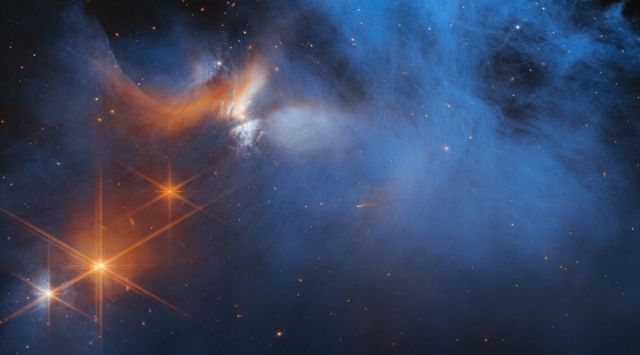Webb telescope helps find ‘building blocks of life’ in dark, cold molecular clouds in space
Researchers have used the James Webb Space Telescope to prove that even complex prebiotic molecules, which are precursors to the building blocks of life, can be formed in the depths of cold, dark molecular clouds.
 The James Webb Space Telescope's view of the molecular cloud Chameleon I. (Image credit: NASA, ESA, CSA, and M. Zamani (ESA/Webb); Science: F. Sun (Steward Observatory), Z. Smith (Open University), and the Ice Age ERS Team.)
The James Webb Space Telescope's view of the molecular cloud Chameleon I. (Image credit: NASA, ESA, CSA, and M. Zamani (ESA/Webb); Science: F. Sun (Steward Observatory), Z. Smith (Open University), and the Ice Age ERS Team.) An international team of astronomers have announced the discovery of different ices in the darkest and coldest regions of a molecular cloud measured to date. According to the European Space Agency (ESA), this will allow astronomers to study the simple icy molecules that could potentially be incorporated into future planets. Also, this could open a window into the origin of more complex molecules that are seen as the first step in the creation of the building blocks of life.
Ices are a vital ingredient of habitable planets since they are the carriers of several different light elements, including carbon, hydrogen, oxygen, nitrogen and sulphur. These are important ingredients in planetary atmospheres as well as molecules like sugars, alcohols and simple amino acids.
In our solar system, it is believed that these elements were delivered to Earth by impacts with icy comets and asteroids. Also, scientists believe that such ices were probably present in the dark cloud of cold dust and gas that would eventually collapse to make the solar system.
The icy dust grains in these dark and cold molecular clouds provide a unique setting for atoms and molecules to meet. This can trigger chemical reactions that can create common substances like water. According to ESA, detailed lab studies have confirmed that some simple prebiotic molecules can form under such conditions.
Apart from simple ices like water, the new investigation allowed scientists to identify frozen forms of a wide range of molecules including carbonyl sulfie, ammonia, methane and even methanol. According to the space agency, this is the most comprehensive census to date of the icy ingredients that can make future stars and planets.
In addition to the molecules that were identified, the research team also found evidence of prebiotic molecules that are more complex than methanol. They couldn’t definitively attribute these signals to specific molecules but the research has proven for the first time that even complex molecules can form in the depths of these molecular clouds.







